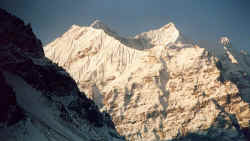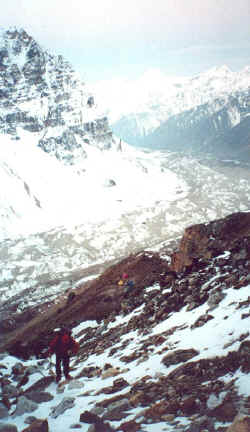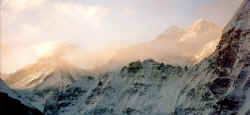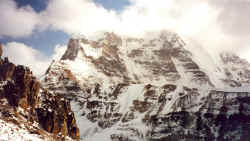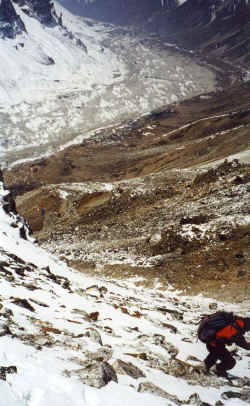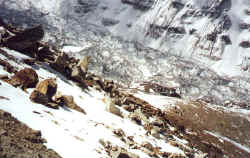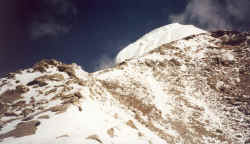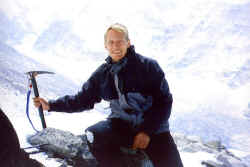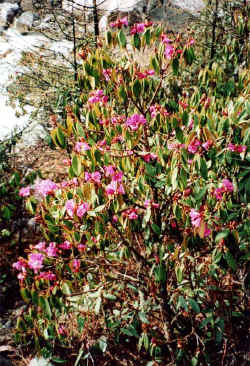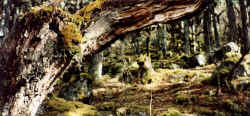MyHimalayasimpressions from |
|
|||||||
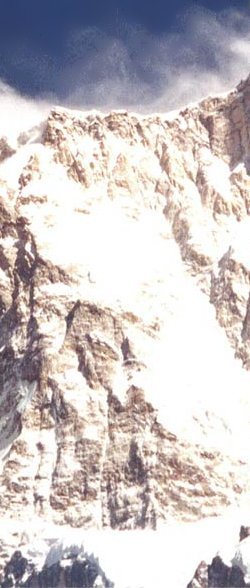
Another beautiful morning in Lhonak.
Leaving high camp and climbing the first couloir in the dawn, glacier and Kangbachen in the background.
During our climb the sun puts Kangchenjunga in an orange light. The ridge of Wedge Peak lies still in the dark.
Drohmo peak, part of the same ridge like Tengkoma.
View down the Kangchenjunga glacier towards Kangbachen. Dendi climbing down towards high camp, the tiny 'plateau' on the left.
We are the little dots on the brown scree.
The ridge continues behind the snow dome, but halfway up Dendi and I decided to turn.
We turn back before the summit, me disappointed. The smile is not faked, though.
After a week in barren rock and snow, the blooming rhododendron on the way to Ghunsa is a wonderful experience.
Fragrant forests, tones of green and yellow make me feel like being in another world again.
Family that runs the guesthouse in Ghunsa, remembering dinner in their house still makes me feel nostalgic.
Kangchenjunga: Tengkoma Climb - Lhonak - Ghunsa
Tengkoma Climb - Lhonak - Ghunsa
Lhonak - Tengkoma High Camp (Day 15)
We climb the mountain in two groups: when the first group was formed some people were unhappy to be in the second group. Though they probably have better chances later because of less snow and better acclimatization, they join us.
Climbing Tengkoma in one day is not feasible, so the plan is to set up high camp at 5'200 meters and attempt the summit the next morning. Preparing all the gear and food takes some time and we enjoy an early lunch in Lhonak. This will probably be the last 'real' meal till tomorrow's dinner. Freeze-dried food is more suitable, above a certain altitude it does not make sense to carry real food, kerosene and kitchen utensils.
We walk towards Pangpema for an hour, take a left turn and start climbing a loose scree slope. The porters have taken a different trail and we see them traversing high above us. Our 'ascent' is not difficult but tiring - a first taste of tomorrow's walk. Despite going slowly, Gombu is breathing heavily, maybe age is taking a toll on him, though this is hard to believe because he climbed Everest a few years ago and is still working for expeditions, or maybe he is feeling sick. His motivation does not seem very big, and he is not getting along with the other Sherpas terribly well.
Nicole is walking in the back with Gombu, I switch my light backpack with her heavy one. I feel comfortable and go ahead, following the small stone pillars which mark the way. I almost walk too far up, but then I see Joel on a grassy shoulder. A few meters below is level space barely big enough for our four tents.
The porters arrive, drop their loads, take a short rest and return to Lhonak. Their strength and work-ethic is incredible. Dendi has built a small kitchen and is boiling water. After putting up the tents fog moves in and hides the views of the glacier and Wedge Peak. While Jannu is stupendous and Kangchenjunga massive; Wedge Peak looks like a fine piece of art with its symmetrical summit and its steep walls entirely covered by finely carved hanging glaciers.
I feel tired now, and there is not much to do. The sherpas love the walkie-talkies and talk to Ram Kaji in Lhonak for a long time. Everybody else sits around or tries to take a nap, most are affected by the altitude but nobody is sick. We are at 5'300 meters, 600 meters higher than Lhonak. Dinner starts earlier than usual, pasta and vegetable on a cheese sauce tastes decent and is filling. We eat outside, surprisingly it is less chilly than in Lhonak.
Suddenly the fog clears, at first only the silhouette of Wedge Peak is visible but then the snow fields shine in a pink light. I wish I had a camera that could capture these moments. Moon and stars are on the sky and it would be time for bed. But my initial tiredness is gone and I lie awake for awhile, when I finally fall asleep I often jerk up because of very irregular breathing. There is giggling from the women's the whole night, Rein whom I share the tent with doesn’t seem to sleep either.
Eventually, it must be an hour before midnight, my breathing gets normal and I fall into a deep, dreamless, relaxing sleep. Except for two toilet stops, I sleep safe and sound until 400 when Joel wakes up the kitchen crew.
Tengkoma Climb (Day 16)
Nobody slept well except for the Sherpas, and the few who finally fell asleep woke up when Joel got up. The hot Tang orange drink is something that both Joel and Jamie swear is excellent, but it tastes disgusting on an empty stomach. Somehow I manage to gulp down a bowl of muesli. Compared to last year's climb of Chulu Far East, things seem hectic.
Nicole is not feeling well, yesterday's climb was tough for her and she has not acclimatized at night. She could probably climb with Diamox, but decides that 'if you're body does not want to go, why push it with drugs?' and will go down later.
It is hard to decide what to wear: right now it is bitter cold but this will change quickly once we start moving and the sun comes out. Long underwear, trekking pants, wind-proof pants, a fleece and a wind-proof jacket are very warm but I can always take things off later. As usually it is freezing cold just before sunrise, I stay in the tent as long as possible and since I assembled my gear (which is not much) yesterday night I am ready in a few minutes. With crampons and ropes the procedure would take much longer. In these conditions, Tengkoma should not require any mountaineering equipment, so I just pack my little daypack, tie my shoes and off we go.
We climb one of the gullies above the camp, the gravel is covered by a hard-frozen layer of snow which makes walking easier. No fresh snow fell in the last 24 hours. It looks like a tough but not very beautiful climb, at least as long as we are in the gullies.
By now the night is over and it is bright enough to turn off the flashlight. It's gonna be a beautiful morning, if not a perfect day. The trekking poles are very useful, but the fingers get cold easily. My feet are also freezing, maybe plastic boots would be a good idea the next time. Everybody goes slowly, after the first couloir we cross into another one and continue through more snow and scramble over loose rock. Despite the steepness, ropes are not necessary and walking on rock is less intimidating then on ice. All that was required so far are strong leg muscles and good lungs.
After the second couloir we traverse on some snow and reach a good place for rest. The sun has risen above the range in the east and illuminates the peaks of Kangchenjunga and Yalung Kang, the ridge of Wedge Peak lies still in the shade. We have gained some altitude and also get to enjoy the warm sunrays. Hand and feet are warmed up, clothes taken off and after a fifteen-minute break we are ready to continue.
A long screeslope lies ahead of us, the white snow-capped summit starts somewhere behind the ridge. I expected Gombu, our Everest-experienced Sherpa, to go ahead but he stays behind - heavy equipment, he laments - and I join Dendi who is leading. The others were reasonably fast so far, now they all slow down. The terrain is less step but more difficult on loose rocks. I try to get a foothold on the bigger, more stable rocks; this technique might take more energy at the first glance, but is probably less tiring than stumbling over the pebbles. I stop less often and I continue towards a ridge.
The views are fantastic and worth turning around often. To the left are Tent Peak and Twin Peak, below them several glaciers meet. If a glacier could be compared to a river, then this would be a lake. Kangchenjunga towers in the middle, not necessarily in height (though it really is the highest point around) but more in its scale and breadth. Its glacier makes a bend at the far right and flows down towards Kangbachen. Lhonak lies somewhere near that curve but I cannot spot the camp with binoculars, though Dave managed to see us from down there.
I'm at the foot of a ridge leading up to the impressive snow dome, which is climbed from the back. Some clouds are forming behind the summit, no reason to worry. So far conditions were surprisingly good; only little snow was on the mountain, the wind was not blowing and no fog appeared. Snow starts to get deeper from here, but most of the bigger rocks look out of it and make it a comfortable place to sit down and enjoy the magnificent scenery. Unlike Chulu Far East which was my first ever climb last year (and I promised myself that it'd be the last one…) and from where the views towards the Annapurna range are fantastic but somewhat distanced, here it is a different feeling because of all the glaciers and mountains that unfold so much closer to you.
I wait some time for the others who are getting slower and slower. The only sound is Joel's coughing which sounds not good at all. He makes it to the ridge before the others and after looking around for some moments declares that we'll have to bail. I'm a bit surprised about his quick decision. Admittedly there is probably more snow than expected and the sky is not crystal-clear anymore, but even I (and admittedly I am not a very brave person) felt comfortable so far. The others turn around.
Joel gives me permission to go on if I want to. Since there is too much snow on the ridge Dendi and I traverse a snowfield of reasonable steepness, far below is the glacier from Drohmo peak. Five minutes later we stand on the ridge again. It looks positively do-able, but definitely strenuous. Gombu has put up prayerflags further down, the definite sign that all the others are turning around. I am undecided. I would continue if Dendi agreed, but he wants to go down.
I don't really have a choice and start with a quick descent. Taking big steps and small jumps down on the gravel slope is the fastest and easiest way, once or twice I slip. Fifteen minutes later Dendi and I are on the saddle above the couloirs. Down to high camp in the steep gullies requires attention and in the beginning we are more careful on the snow slopes, but then start 'skiing' down on our shoes. We're at camp in no time.
Hot noodle soup is waiting there for us. I help packing everything up and after a relaxing nap start with the walk to Lhonak. Soon I am near the Kangchenjunga glacier and hop from stone to stone across the little rivulets in the warm sunshine. The sound from the brooks and birds' chirping are idyllic after the harsh desolation at 6'000 meters. It is a relief to walk on flat turf instead of ankle-twisting rocks. The quick descent is rewarded by getting to Lhonak camp just as dal baht is served.
I am disappointed and grumpy - not because we failed, but why we failed. I am not an eager climber, and I did not spend too much energy or emotions. Though Tengkoma is higher than Chulu Far East, it is less of a challenge and last year's climb felt like a bigger achievement. Nevertheless, it just sucks because it would have been so easy to climb Tengkoma. In retrospect, maybe I should have continued with Dendi. We were both strong and in any case could have turned around if conditions had deteriorated.
The amenities at camp help me over my initial bitter feelings. After another round of playing Frisbee with the porters I sit in the hut and have a great time with the crew. My spirits vastly improve.
In the afternoon the others arrive, after dinner we go to bed a little earlier than usual.
Lhonak - Ghunsa (Day 17)
The long group will stay for quite some days, Dave's exploring of Chabuka valley towards the pass was successful and he is eager to set foot on the Tibetan border (and probably a few steps further). The Indian pundit who crossed the pass in 1879 called it '…the very picture of desolation, horror, and death, escaping the treacherous crevasses which abound in this dreadful region'. Doesn't this sound like a worthwile destination?
The short group will leave for Ghunsa tomorrow, they want to rest and relax one more day up here. I usually accept group decisions and try to move individually within this 'boundaries'. This works fine for me, the comfort of a group usually leaves plenty of time and room for your own ideas and excursions, but despite its great views Lhonak is not a place where I can spend an entire week. The lack of civilization and the prospect of more snow in the coming days (clouds in the afternoon) gets me thinking about leaving for Ghunsa earlier. Joel did not seem to have a problem with my decision when I talked with him about it the previous evening.
I wait with my final decision till after breakfast to see what plans the others have. They will stay one more day and then also go back to Suketar via Ghunsa. I decide to walk to Ghunsa today and wait for them there. We take a group picture of us and the porters, kitchen crew, Sherpas and our Sirdar Ram Kaji. They did truly a great job, all of them. Ram Kaji organized everything very smoothly. I am sure there were complicated situations, but thanks to his relaxed and gentle manners we never found out about it. I stuff all essentials in my small daypack (warm clothes, toiletries, a book, some snacks) and carry the sleeping bag. I get my trekking permit, give Joel the well-deserved tips for the crew, leave some old clothes with the porters and am ready to set out around 1000.
I will meet the short group tomorrow night in Ghunsa, and members of the long group in Kathmandu. I am pretty sure to meet most of the crew (Dendi, Bagman, Ram Kajii) on future treks, so the good-bye ceremony is short. Dark clouds are on the sky far away in the south by the time I am ready. Depending on the wind rain-clouds move very fast, prompting me to hurry up and take the trail to Kangbachen without too many stops. The landslide areas between Kangbachen and Lhonak are short and easy to oversee, otherwise I wouldn't have gone (or be allowed to go) on my own.
Soon I pass the place where we had lunch on the way up; I turn around for the last view of the wide glacial valley with Tengkoma. Two hours later I reach the prayerflags above Kangbachen. The houses on the hillside and our lodge are deserted, after crossing the bridge a group is having lunch at another lodge. It is time for some rest and after a solitary walk I am happy to share food and thoughts with other trekkers. The four Frenchmen are really nice, though a bit bewildered at first as they think I am on my own and that this is all my equipment. They have been to Nepal quite a few times, had bad luck with weather in the Solo Khumbu before. They stayed in Lhonak and are now on they way back to Ghunsa. I decline offers for lunch, share Swiss chocolate as dessert instead (they are even more shy and reluctant than Nepalis).
Jannu is barely visible through the mist, but unlike most tourists we met we did get great views and could follow our itinerary as planned. I continue on my own because the clouds have intensified and I want to get past the big landslides before it starts to rain. If it proves too dangerous I could probably stay in Kangbachen or in the worst case head back to Lhonak.
The trail over the landslide looks different than a week ago, the precipitation that fell as snow further up most have caused it. Right now it looks safe and I cross it quickly with open ears and eyes. At noon I am at Rambu Kharka where a red handwashing bucket on a tripod and a matching towel are the first sign of Western civilization. The kitchen crew of a World Expedition group are preparing lunch.
Walking through forest is a pleasure after days on barren rock and snow. The smell, the colors, the sounds create an atmosphere that is very refreshing. Small brooks flow between boulder covered by moss, the trail is covered by dead leaves. A caravan of yaks carrying duffle bag passes me, they are followed by a big group of tourists and some known faces from Ghunsa. The usual conversation starts: "Tashi deleg, where are you going? Where are you coming from? Go slowly. Take care". It feels good to make a little use of my Tibetan. Hopefully it will prove more useful when I am on my own in Ghunsa. Near the bridge I meet some teenage porters who are far behind the group and carry heavy loads.
Now that I have crossed the rockslide-area and entered the fragrant forest of firs, larches and junipers, it should be only a short trek to the village. But it proves an endless afternoon. Well, it doesn't take more than an hour, but a few raindrops set my mind to reaching Ghunsa without fully appreciating the walk. This makes every minute seem much longer. Luckily it does not start to rain heavily until much later and I come to enjoy the walk more and more. Was it really that beautiful on the way up? Probably yes, but back then I was eagerly awaiting alpine scenery. Just as the rain increases I see a prayerflag, ten minutes later I am passing the mani wall and prayerflag and I see the smoke seeping through the roofs of Ghunsa.
The village is very quiet, nobody is outside and no bright-coloured tourist tents hurt the eye. The guesthouse where we camped before is closed, but the owner's wife sees me and comes over to show me the rooms. The wooden booths are small but clean and seem to have good windows. In Tibetan I ask the price, it is so reasonable that I feel a little ashamed.
After settling in and having changed into clean and dry clothes she waves me over into the comfortable living room. Amala has a beautiful young Tibetan lady as a guest; both wear a fine dress and jewelry and enjoy an afternoon gossip, a "kaffeeklatsch". They drink a little Tongba and have some snacks. I am offered butter tea and potatoes, both of which I happily accept. The potatoes with salt were one of the best meals I have ever eaten in my life. Sitting near the fire and listening to the conversation make me realize once again how great trekking is.
While siping the hot tea and enjoying the boiled potatoes I watch the increasing rain through the little wooden window. When the Frenchmen arrive soaking wet a few hours later I don't regret having gone on my own. Hurrying down from Lhonak in 41/2 hours was worth the sore muscles I'll get tomorrow.
Before it gets dark two more tourists arrive, they are on their own and share a Nepali guide / porter. The American guy is about my age, speaks Nepali and is a pleasant. He met the young German he treks with some days before and they decided to trek together but had lots of rain so far. The German guy is not very knowledgeable about local customs. Their guide is not any less annoying, he smokes in the house, turns on the radio and plays an annoying tape. Before I find out if our host's patience is being tested one of her kids turns off the tape deck.
I play with the little kid, later Dondup arrives with a young girl whom he picked up from school. I am a little confused about family relations, later they show me their picture album which confuses me even more: who is who son or daughter or daughter-in-law?
Earlier I gave some chocolate to amala, she saved half of it carefully wrapped up and gives it to her husband before dinner. It's impossible to describe the way this couple treats each other, intimacy is not shown in public, but the respect and care is overwhelming and shows in little gestures. They remind me of Mr. and Mrs. Jones on last year's Manaslu trek.
Usually it is the 'daughter' who takes care of the house and prepares food. Tsering also cooks for the guests in the lodge. The curry potatoes are delicious, the dal baht is equally tasty. It is a superb dinner. Tsering blushes when she hears the compliments.
Around 2000 I get tired and soon go over to my room for some sleep. Rain hits the roof, but not even lightning and thunder can prevent me from falling asleep quickly.
Ghunsa - Rest Day (Day 18)
I can't believe that after more than two weeks of walking a few hours of quick hiking made me so tired. I've slept very well until rooster wakes me. It is only 700 though it looks much brighter outside: it snowed an inch over night. This greatly increases the coziness of my little chamber.
When fog and clouds disperse the sun is strong enough to melt the snow within minutes. The last pieces of Swiss chocolate are my breakfast, and then I doze off again to the rhythm of the constant dripping of melting snow. Two hours later I finally get up, enjoy a cup of tea and walk around in town.
The valley's history is more turbulent than it seems; unlike other important trading routes (e.g. Kali Gandaki or Marsyangdi in the Annapurna area) we haven't seen any old fortress or dilapidated castles. For a long time this side of the Kangchenjunga also belonged to Sikkim, then it was invaded by Nepal. A fight between the 'indigenous' people from Kangbachen and Nepali Magars provoked the Tibetan to intervene and push the Magars further south. Maybe they wanted to secure pastures, or trading routes, or were just afraid of a powerful neighbour.
After the brilliant morning clouds start coming in, another good excuse not to walk to Phale. I had a nice time there on the way up and originally wanted to visit the school. But some of the people I met on their way to Kangbachen were from Phale, so they town might be less lively. And Ghunsa is such a pleasant place that the risk of walking in the rain is not worth it.
I skipped breakfast and enjoy another fantastic dal baht with potatoes. Today is Saturday, Nepal's holiday. People cannot afford to do nothing, but they avoid hard manual labor and stay near their house. Clothes are washed, kids are forced take baths in lukewarm water and friends and neighbors are visited. They put on their best dress and ornaments.
A little bit of Tongba and delicious tsampa is served, together with spicy sauce. I am too full after lunch to enjoy the special treat. When too many uninvited guests (customers) crowd in the living room, the guests disappear and probably spend a relaxed evening at a neighbor's house.
Two trekking groups arrived, and while the tourists are fine their Nepali guides act like jerks. They all huddle around the fire, but he drink too much and tries to act cool. I catch up with my diary, trying to remember the last few days and ignore him. The local police invited themselves to a neighbor's house; they seem pretty drunk and sing till late at night. First I thought they celebrate because today is Nepal's National Holiday. But when I see the disapproving face of Dondup I realize that their arrogant behavior is more the norm than the exception.
Rain gets heavier and heavier but nobody of my group has yet shown up. When dusk sets in, John and Cynthia arrive. Lucy follows an hour later with Bagman. Nothing could move me from my place in the living room because a) it is so cozy and b) Tsering's curry potatoes cannot possibly be matched by any cook.
|
Summary Part 4:
Dozens of peaks are crammed around the massif. One of the smaller mountains is Tengkoma, a steep scree slope that ends in a snow dome. We will try to climb it, from its summit at 6'215 meters you can see even Mount Everest on clear days. The climb starts in the early morning from high camp at 5'300 meters. Struggling up the couloirs is tiring but technically easy. While we climb, the sun rises and illiminates Kangchenjunga. The level of snow increases as we ascend, at 6'000 meters it is decided to turn around. Spring has arrived while we had snow in Lhonak every night. After a week in the cold barren alpine scenery, the fragrance of flowers and trees on the way to Ghunsa is overwhelming. |
